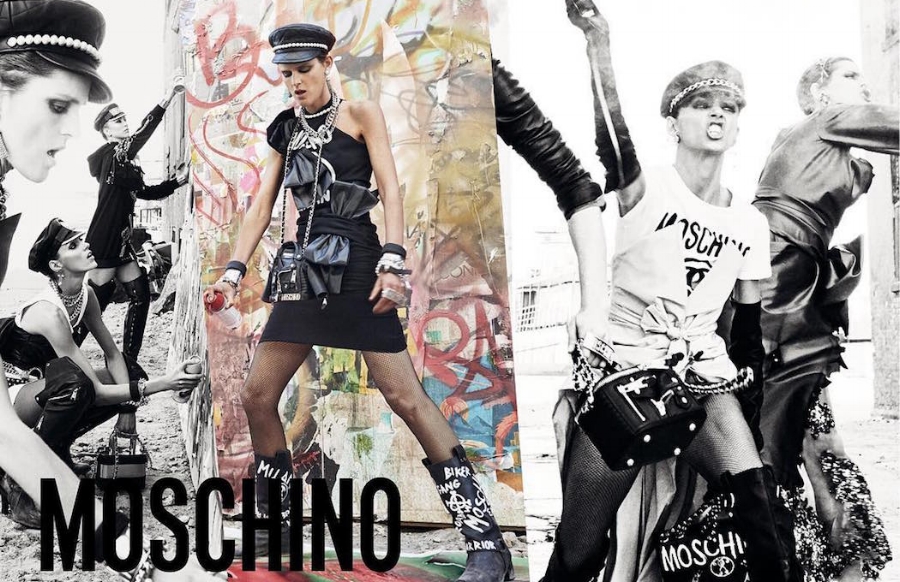
image: Moschino
While Jeremy Scott was putting graffiti on dresses for Moschino (and getting sued over it) and Demna Gvasalia took to tagging Balenciaga’s classic motorcycle bags for a “Graffiti Collection,” a fierce battle was underway outside of the fashion industry. For the past 4-plus years, a group of 21 graffiti artists have been embroiled in a legal war over the works that until 2013 adorned the side of 5Pointz – an industrial complex in Queens, New York. The suit centered on “a rarely tested provision of federal law,” the 1990 Visual Artist’s Rights Act (“VARA”). As of this week, they prevailed.
The 21 graffiti artists filed suit in 2013 after developer Jerry Wolkoff whitewashed the art they have created on the side of the 5Pointz buildings. Wolkoff had, for the past 20 years, invited taggers to showcase their art on his industrial complex, turning it into – in the words of the artists’ lawyer – the “world’s largest outdoor open aerosol museum.” But then, just after nightfall on a fateful day in mid-November 2013, Wolkoff oversaw the whitewashing of the graffiti before demolishing the site in 2014, making way for a planned $400 million luxury residential complex.
In doing so, Wolfkoff, despite widespread protest from graffiti artists, some as well-known as Banksy, allowed “erased the work of hundreds and seemingly putting the final nail in the long battle between the building’s owners, who plan to erect luxury apartments, and the artists who fought to save it,” according to the New York Times.
“The fact that they destroyed the art before they razed the building, it’s a really big slap in the face,” said Eric Felisbret, an expert on street art and the author of “Graffiti New York.” “So many people put so much passion and energy into it.”
The legal battle started even before that, though. The group of street artist plaintiffs filed suit in October 2013 in the U.S. District Court for the Eastern District of New York against Wolfkoff, shortly after he received approval from the New York City Council to demolish the 200,000-square-foot factory building in order to build housing towers in its place.

image: AP
According to the complaint, the proposed demolition stood to violate the artists’ rights under VARA, legislation that gives certain copyright owners the right to prevent the destruction of a work of art if it is of “recognized stature.” While U.S. District Judge Frederic Block previously recognized the significance of the artwork (which according to 5Pointz’s complaint “is listed in every major guidebook covering New York City, and is included in over 100 international travel guides, as well”), he ultimately held that Wolkoff had the right to develop the property as he chooses and allowed for the plans for demolition to move forward.
In a newer lawsuit, the same group of artists alleged that Wolkoff ran afoul of VARA by whitewashing their artwork prior to the destruction of the warehouses. According to the suit, which was filed in the U.S. District Court for the Eastern District of New York in June 2015, they were not given any warning from Wolkoff that the art would be painted over and as a result, did not have the opportunity to pull down or preserve their artwork.
The graffiti at issue, according to the suit, amounts to artwork of “recognized stature,” thereby, enabling the artists to rely on VARA for protection and recourse. They are claiming an array of monetary damages.
Late last year, almost exactly four years after Wolkoff had the buildings whitewashed shortly after sunset, a jury sided with the 21 graffiti artists. But as writer/attorney Jessica Meiselman wrote at the time, “The verdict against Wolkoff … was not the final word in the case due to an agreement reached between the parties prior to the start of jury deliberations. Instead, the judge presiding over the case will ultimately decide the lawsuit’s outcome.”
As of this week, Judge Block held that in abruptly whitewashing of the graffiti, Wolkoff intentionally ran afoul of VARA. In finding for the graffiti artists, the judge has ordered Wolkoff to pay $6.75 million in damages – the maximum possible amount of statutory damages, $150,000 for each of 45 works that were destroyed – holding that but for “Wolkoff’s insolence, these damages would not have been amassed. If he did not destroy 5Pointz until he received his permits and demolished it 10 months later, the Court would not have found he had acted willfully.”
Judge Block further stated, “The shame of it all is that since 5Pointz was a prominent tourist attraction the public would undoubtedly have thronged to say its goodbyes during those 10 months and gaze at the formidable works of aerosol art for the last time. It would have been a wonderful tribute for the artists that they richly deserved.”
Eric Baum, lawyer for the artists, welcomed the decision. “The decision is a clear indication that aerosol art is in the same category as any other fine art, equally worthy of the protection of federal law,” he told AFP. “Their art should be cherished and not destroyed.”














